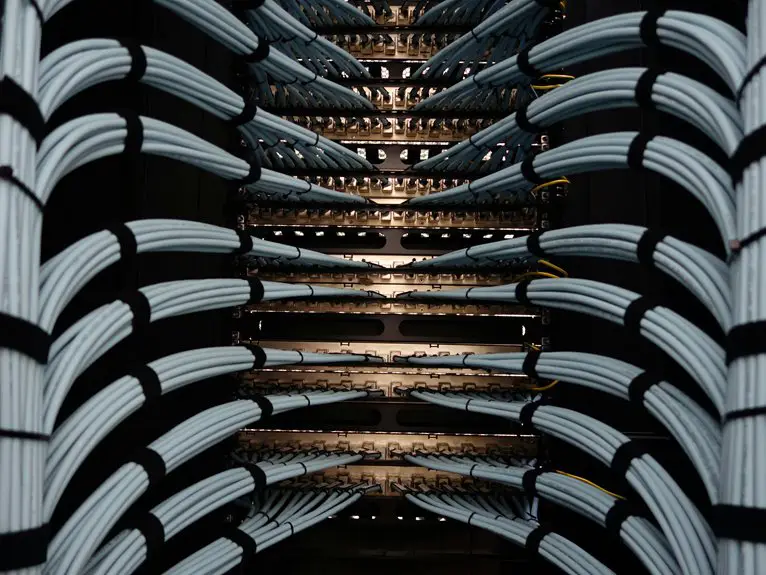Boosting efficiency with a well-managed cable system can transform your workspace. By organizing your cables, you eliminate clutter and reduce tripping hazards, creating a safer environment. It also simplifies troubleshooting, allowing you to tackle tech issues quickly. Plus, well-managed cables can enhance airflow and device performance. As you optimize your setup, you'll likely find new ways to keep everything tidy. Discover more best practices and tools to elevate your cable management strategy.
Table of Contents
Key Takeaways
- Organized cables reduce clutter, improving workspace aesthetics and making it easier to focus on tasks.
- Proper cable management prevents accidents by minimizing tripping hazards and accidental unplugging.
- Efficient airflow around devices enhances cooling, boosting overall performance and longevity of equipment.
- Labeling and color-coding cables streamline troubleshooting, saving time and increasing productivity.
- Regular maintenance and reorganization of cables adapt to new devices, ensuring a continuously efficient workspace.
Understanding the Importance of Cable Management
When you consider the countless devices we rely on daily, it's clear that effective cable management is crucial for both efficiency and safety. Properly organized cables not only create a tidy workspace but also prevent hazards like tripping or accidental unplugging.
When you manage your cables well, you enhance airflow around your devices, which can help them operate more efficiently and last longer. You'll also find it easier to diagnose issues or make changes to your setup, saving you time and frustration.
Plus, a neat cable system reflects professionalism, whether in your home office or a business environment. Overall, investing time in cable management pays off by boosting productivity and creating a safer, more organized space.
Common Cable Management Challenges
Despite the benefits of effective cable management, many people encounter common challenges that can hinder their efforts.
Effective cable management offers numerous benefits, yet many face challenges that can obstruct their progress.
You might find yourself facing a few key issues that complicate the process:
- Tangled cables: It's easy for cords to intertwine, creating a chaotic mess.
- Lack of space: You may struggle to find adequate room for organizing your cables neatly.
- Inconsistent labeling: Without clear labels, identifying cables can become a frustrating game of guesswork.
- Limited resources: You mightn't have the right tools or products to manage your cables efficiently.
Recognizing these challenges is the first step toward overcoming them.
Best Practices for Organizing Cables
Effective cable organization can significantly enhance your workspace's efficiency and aesthetics. Start by identifying and labeling each cable; this helps you quickly find what you need.
Use cable ties or Velcro straps to bundle cables together, reducing tangles. Consider color-coding your cables for easy identification—this saves time and effort.
Make use of cable trays or raceways to keep cables off the floor, minimizing tripping hazards. Ensure cables are routed away from high-traffic areas to prevent wear and damage.
Regularly check for loose or damaged cables and replace them promptly. Finally, maintain a consistent routine for cable management; it's easier to stay organized when you make it a habit.
Tools and Solutions for Efficient Cable Management
To keep your cables organized and efficient, you'll want to explore various cable organizers and accessories that simplify your setup.
Additionally, innovative management software solutions can help you track and manage your cables more effectively.
Let's look at the tools that can transform your cable chaos into a streamlined system.
Cable Organizers and Accessories
When you're tackling cable management, the right organizers and accessories can make all the difference in achieving a tidy workspace.
Investing in these tools not only enhances aesthetics but also improves safety and efficiency. Here are some must-have items to consider:
- Cable Clips: Keep cords securely attached to surfaces, preventing tangles and tripping hazards.
- Cable Sleeves: Bundle multiple cables together, offering a neat appearance while protecting from wear and tear.
- Cable Ties: Use reusable or Velcro ties to organize excess lengths and keep cables from sprawling.
- Cable Management Boxes: Hide power strips and excess cords, reducing clutter and creating a streamlined look.
Innovative Management Software Solutions
As you seek to streamline your cable management process, innovative software solutions can play a pivotal role in enhancing efficiency and organization.
These tools offer features like real-time inventory tracking, detailed mapping of cable routes, and automated maintenance alerts. You can easily visualize your entire system, helping you identify bottlenecks and optimize layouts. Moreover, many solutions integrate seamlessly with existing infrastructure, allowing you to manage everything from a single platform.
Utilizing data analytics, these programs help you forecast future needs and assess performance metrics. This not only saves time but also reduces the risk of costly downtime.
The Impact of Cable Management on Workplace Safety
Effective cable management not only enhances the efficiency of your workspace but also plays a crucial role in ensuring workplace safety.
By organizing cables properly, you significantly reduce the risk of accidents like tripping or electrocution. When you implement a well-maintained system, you're creating a safer environment for yourself and your colleagues.
Here are some key benefits of good cable management:
- Minimized tripping hazards: Neatly arranged cables prevent stumbling.
- Easier maintenance: Organized cables simplify troubleshooting and repairs.
- Enhanced airflow: Properly managed cables improve ventilation for devices.
- Professional appearance: A tidy workspace promotes a positive impression.
Prioritizing cable management not only protects your team but also fosters a more productive atmosphere.
Evaluating Your Cable Management Strategy
To optimize your cable management strategy, start by identifying any current cable issues that may be hindering efficiency.
Next, assess your organization techniques to see what's working and what's not.
Finally, implementing best practices will help you maintain a tidy, functional workspace.
Identify Current Cable Issues
How well do you really understand the cable issues plaguing your workspace? Identifying these problems is the first step to improving your cable management strategy.
Take a moment to evaluate your current setup. You might be surprised by what you find.
Here are some common issues you could encounter:
- Cables tangled and knotted, creating a messy appearance
- Inadequate labeling, leading to confusion when troubleshooting
- Cables running across walkways, posing safety hazards
- Excessive dust accumulation on unorganized cables, risking equipment damage
Assess Cable Organization Techniques
Once you've pinpointed the cable issues in your workspace, it's time to evaluate the organization techniques you currently use. Start by observing how your cables are arranged. Are they tangled or neatly bundled?
Check if you're using cable ties, clips, or trays effectively. If your cables frequently cross paths, consider redesigning the layout for better flow.
Next, assess your labeling system. Are cables clearly marked to avoid confusion? You might find that color-coding helps in quickly identifying which cable belongs to which device.
Finally, think about accessibility. Can you easily reach your cables for adjustments? By taking a close look at these techniques, you'll identify areas for improvement that can streamline your cable management strategy.
Implement Best Practices
As you evaluate your cable management strategy, implementing best practices can significantly enhance efficiency in your workspace.
Start by organizing cables to prevent tangling and ensure easy access. Use labels to identify each cable's function, making troubleshooting a breeze. Consider employing cable trays or sleeves to keep everything neat and tidy. Regularly inspect your setup for wear and tear, addressing issues before they escalate.
Here are some best practices to adopt:
- Label Cables: Clearly mark each cable for easy identification.
- Use Cable Ties: Group cables together with reusable ties to reduce clutter.
- Plan Layout: Strategically position cables to minimize interference.
- Schedule Maintenance: Set regular check-ups to maintain optimal conditions.
These steps can transform your workspace into a more efficient environment.
Frequently Asked Questions
How Often Should I Reassess My Cable Management System?
You should reassess your cable management system at least every six months. Regular checks help you identify issues, keep things organized, and ensure optimal performance. Don't wait until problems arise; stay proactive for best results.
Can Cable Management Improve Overall Team Productivity?
Absolutely! When you manage cables well, it reduces clutter and distractions. A tidy workspace helps you and your team focus better, streamline tasks, and ultimately boosts overall productivity in your work environment.
What Are the Environmental Benefits of Good Cable Management?
Good cable management reduces electronic waste by prolonging equipment lifespan, minimizes energy consumption through efficient organization, and promotes recycling by simplifying the disposal process. You'll contribute to a cleaner environment while enhancing your workspace.
How Do I Train Staff on Cable Management Practices?
To train your staff on cable management practices, start with hands-on demonstrations. Encourage questions, provide clear guidelines, and create visual aids. Regularly review their progress and offer feedback to reinforce best practices and maintain organization.
Are There Specific Regulations for Cable Management in Workplaces?
Yes, there are specific regulations for cable management in workplaces. You should familiarize yourself with safety standards and industry guidelines, ensuring compliance to prevent hazards and maintain a safe, organized work environment for everyone.




